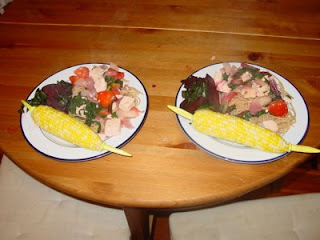Yesterday I got the urge to go to a Farmers' Market. I checked a
handy-dandy Massachusetts Farmers' Market list, and saw the only Sunday market was in Charles Square in Cambridge. So it was an easy decision where to go! There were only about 5 or 6 vendors there, and I couldn't find any eggplant, which was the original reason for making the trip, but it was still fun and we got plenty of stuff.
One of the neat things we got was a bunch of squash blossoms. Let's be honest: squash blossoms are one of those ingredients that are a big pain in the patootie. They're a lot of work, they have to be used nearly immediately, and they are relatively expensive (we paid $4 for a bunch of about 12 blossoms). But I just can't resist, at least once a year.

I went with a fairly traditional stuffed squash blossom recipe I came up with based on what I had on hand. Then I battered them and deep fried. My husband made cilantro serrano cream sauce, that was a perfect accompaniment. Here are the recipes:
Stuffed Squash Blossoms:
Ingredients:Approximately 12 squash blossoms
12 oz. ricotta cheese
2 cloves garlic
2 tablespoons finely diced onion (or shallots)
1 teaspoon butter
Freshly cracked black pepper
Directions:Gently wash the squash blossoms, then reach in and remove the inside stuff (the stamen, I think it's called). It's fine if the blossom rips down one side.
Melt the butter in a small pan over medium heat. Finely dice the garlic and onion, and add to the pan. Saute until slightly softened. You can skip this step if you like the crunch/bite of raw onion and garlic.
In a medium bowl, mix together the ricotta, onions and garlic, and black pepper to taste.
Place the cheese mixture in a pastry bag with no tip. Believe me, I used a tip and learned my lesson. Even though I had very finely minced the garlic and onion, about halfway through stuffing the blossoms, a piece that was slightly too large got stuck in the tip and I had to take the whole thing apart to get the tip out. After that, I used the bag with no tip and it was fine. Anyway, load up the pastry bag and fill each squash blossom until about 1/2" from the top. Don't overfill, especially if you ripped the blossoms along one side, as it will just all leak out. Twist the top slightly to seal the blossom. Repeat until all blossoms are stuffed.
For the batter, I used
this recipe as a starting point, but had to make some changes. It made far more batter than I needed, so you might want to have some other veggies on hand as well to batter and fry.
Batter ingredients:1 1/2 cups flour
3/4 cup cornstarch
1 Tablespoon baking powder
1/2 tablespoon baking soda
1/2 teaspoon salt
1 egg, beaten
1/2 cup ice cubes
1 1/2 cups cold water (or less...add slowly)
additional flour for dredging
Vegetable oil for frying
Directions:Mix the dry ingredients together, then add the egg, ice cubes, and about 1/2 of the cold water. Stir them together (a single chopstick is the best thing to use...you definitely don't want to over mix). Keep adding water until you've reached a thin pancake batter consistency. Don't make this early...you need to use it pretty soon after you've mixed it.
Place enough vegetable oil in a wok or heavy bottomed pan to fry the squash blossoms. Heat over high heat. I only put enough oil to cover about 1/2 the blossom and then just flip the blossom halfway through cooking.
Roll the squash blossoms in flour to coat, then hold the stem and dip the blossom in the batter until coated. If the batter doesn't cling to the blossoms, it's too thick. Add a little more cold water to thin it.
Place the blossom in the hot oil. Repeat until all blossoms are in the oil. It'll probably be time then to start flipping the first blossoms you added to the oil. The batter should be golden brown when finished, about 2 minutes per side.
Remove to paper towels to drain.
_______________________
You can eat the squash blossoms plain if you'd like. We served ours with a
cilantro serrano cream sauce, following the linked recipe. It's a perfect recipe for all you Waltham Fields members as we're getting Serrano peppers now as well as garlic. Our garden is also full of cilantro, so it's really the ideal time for this recipe.
We thought the recipe as written was slightly too mayonaisse-y. If we make it again (and we will), we'll probably replace some mayo with milk or cream. Oh, and we only used one serrano pepper to make it less spicy for our kids, and more importantly, because we only had one serrano pepper. It was just slightly spicy. If your kids will eat spicy foods, I'd probably use at least two peppers. Or make it with one, take some out for your kids, then add an extra pepper or two to the rest of the sauce for the adults.
The cream sauce was delicious over chicken as well. Probably not of interest to all you vegetarians, but I figured I'd mention it for any other omnivores who pop by.
_______________________
I should add why I thought this was a kid-friendly meal. I figured: flowers, neat. Cheese, always a hit. And deep-fried, that's a home run! The flavor of the stuffed blossoms is fairly plain. Good, but not overwhelmingly flavorful for young palates.
Of course, my kids would have needed to taste these to realize they would have liked them. Ah well...maybe people with more adventurous kids will have more luck! The adults in our house loved these, and one of my sons really loved to help prepare them even if he didn't try it. So it wasn't a total loss.







































